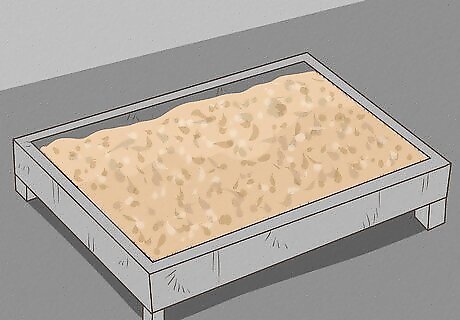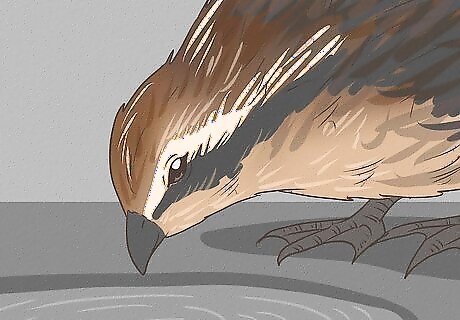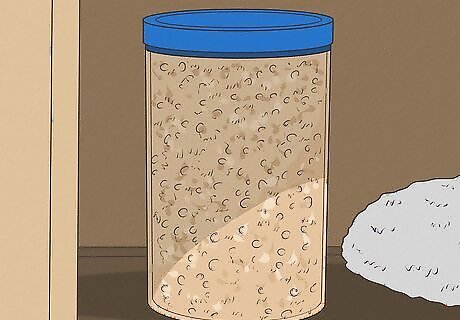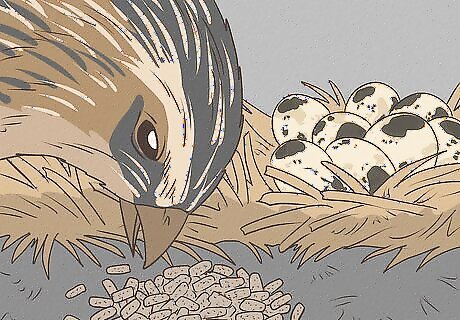
views
Providing Basic Food and Water

Purchase high-quality quail feed from a feed store or from online. Unlike other fowl, quail cannot eat low-quality feed without sacrificing health. This is especially important when it comes to quail being raised for breeding and laying eggs. If you can't find high-quality quail feed, try another type of game bird feed. You can also try turkey feed, which is usually higher in protein than chicken feed, making it more suitable for quail. Chicken feed can make a decent substitute for meat quail. If you choose to go with turkey feed, make sure that it is non-medicated. Always refer to a qualified nutritionist before you make any substitutions. About 80% of a quail's diet will consist of grains. Most quail or game bird feeds will consist of: cracked corn, grains (barley, oats, rye, and wheat), millet, milo, oat grouts, popcorn, safflower seed, sunflower kernels, and sunflower seeds.

Give the quail enough food, and make sure that the texture is right. Quail are easy to feed in that you do not have to worry about over-feeding them. They will stop eating once they feel full. However, quail are picky when it comes to the size of their food. If the grains or pellets are too small or too big, they won't eat it. It has to be just right. They are also messy eaters, so make sure that you put the food in a dish, feeder of trough deep enough that nothing spills. If the feed comes in pellet form, try breaking it up into (quail) bite-sized pieces. Make sure that the pieces are consistent, or the quail will just pick out the pieces they like best and leave the rest. This can result in an in-balanced diet. Avoid mashed feed, if you can. If you must use mash feed, make sure that it is not too powdery. The powder can easily get in between the quail's toes and cause infections. Adult quail will eat about 20 to 25 grams of food a day.

Keep the feed troughs clean, dry, and easily accessible. Make sure that you place the troughs in a dry place, away from rain, snow, sunlight, and wind. You might want to place the food further away from the water troughs as well. If the feed gets wet, it can grow mold, which can kill quail. Also, you should empty the feed troughs often. Only wash the troughs when they become dirty from waste, or if the feed itself gets wet. Make sure that the food trough is level with the quail's crop area. Try to use linear troughs, with enough space for the quail to eat comfortably without competing for food. Depending on how many quail you have, you may need to empty the troughs as little as two to three times a week, to as often as once a day. Quail can be messy eaters. Consider keeping the feed in a hopper with "anti-spill fingers."

Offer plenty of water, and make sure that the quail have easy access to it. As a general rule, the water trough should be no higher than the bird's back. Many quail breeders also recommend keeping marbles in the bottom of the trough. This not only makes the water more attractive to the quail, but it also gives quail chicks an escape route in case they fall in. Quail are guzzlers. Consider making your own guzzler by digging a shallow hole in the ground, lining it with plastic, and then adding a ramp into the hole.

Keep the water troughs clean and replace the water daily to minimize bacteria growth. Clean the trough three times a week with a commercial, nontoxic disinfectant. Don't pour the old water out inside the pen. The pen must be kept as dry as possible. Pay special attention to the water during the winter time. Don't let it freeze. Add a little bit of apple cider vinegar to the water from time to time. This kills parasites and makes the feathers look nicer.

Store the food in a clean, dry place, and use it before it expires. If you don't store the food properly, it can get moldy, which is deadly for quail. It can also become food for other critters, such as insects and rats. Use the feed before it expires—usually 3 weeks after the manufacturing date. You may need to use it even sooner if you live some place hot and humid. Throw away stale or foul-smelling feed. This indicates that the feed has either expired or gone moldy. Rats can not only eat all of the quail's feed, but also contaminate it.
Providing Supplemental Food

Offer some fruit and vegetables. About 20% of a quail's diet will consist of vegetables, fruits, leaves and other roughage compose. Don't be afraid to offer some other type of food. Try to consider the quail's natural, habitat, however. For example, if you have quail that are naturally found in the desert, offer some cactus fruit. Consider planting some berry shrubs, such as: blackberry, currant, huckleberry, manzanita, Oregon grapes, salad, serviceberry, and snowberry. Offer vegetables, such as: broccoli, cabbage, carrots, cucumber, peas, lettuce, and turnip greens. Be careful with tomatoes. Quail can eat ripe tomatoes, but they cannot eat any other part of the plant, including the leaves and the stems.

Consider offering other types of food as well. The main part of a quail's diet should be specialized quail feed. However, it you can include other types of food as a treat, such as: cake, pasta, rice, and sweet corn. Quail love nuts and seeds. Consider having some nut or seed bearing trees around, such as: ash, cascara, hazelnut, and oak. The quail will eat the nuts and seeds that the trees drop. Quail also love insects, especially chicks. Insects are full of protein, which chicks and egg-laying hens need.

Know that some types of foods can be toxic to quail. This includes avocado, caffeine, chocolate, grape seeds, meat, parsley, rhubarb, the stems and leaves of tomato plants, salty foods and treats, uncooked potatoes, and most citrus fruits. Quail will avoid anything toxic to them unless they are starving. This indicates that you should feed your quail more. There are many plants that are poisonous to quail, but you most likely will not come across them anyway. It is still important to be aware of this, though. Avoid giving quail anything from your garden. The quail will figure out quickly where their food comes from, and may try to feed themselves. This may not be good for your garden.

Provide a bowl of grit for your quail. This helps your quail digest their food down; however, if they wander about on the grass often, this is not a big worry for them as they will find some goodies in the ground to digest their food with.
Feeding Through Different Life Stages

Feed chicks a starter soon after hatching until they are 6-8 weeks old. Chicks need plenty of protein, which is found in the starter feeds. The starter feeds also offer other nutrients and vitamins that enable the chicks to grow into healthy, fully-grown quail. Use long, straight troughs for brooding chicks. Transition to circular feeders after the chicks are 2 weeks old. Use a smaller bowl for water. Chicks can eat fine crumble until they are 6 to 8 weeks old. A coarser texture, or pellets, are better for older quail. When raising chicks, teach them how to drink by dipping their beaks into the bowl/dish. If they have their mother hen with them, this is not much of a worry as she will show them how to drink.

Feed your quail a good-quality developer feed after six to eight weeks of age. The best feed for quail is a game bird feed that has at least 20 percent protein or more. Quail feed is expected to have plenty of protein to enable them to have a balanced diet for them to grow into great, healthy pets. If you are planning on using the quail for their meat, you do not need to give them a developer feed. Give them a finisher feed instead. If you are going to use your quail for breeding or laying eggs, slowly transition them to the new diet before they hit 10 weeks of age.

Feed your quail's layer-pellets after they start laying eggs. Layer-pellets provide enough calcium for your quail to lay strong, healthy eggs. Make sure to grind the pellets up a bit if you find the quail quite big for them. This is especially important if you buy chicken pellets, as these are bigger than the quail layer-pellets. Just make sure you don't grind them up into a powder.

Always provide a fresh supply of water. Clean the water bowl one to three times a week and refill once a day. The bowls will tend to get dirty, as the quail will often stand in them, spill dirt/bedding in them and do all-sorts!
Feeding for Different Purposes

Find out what you want to do with the quail. Do you want to raise them for eggs, meat, breeding or just as a simple pet? Quail need a diet depending on their purpose as you'll need to choose a feed that suits them. The four main different types of feeds are: Starter Developer Layer Finisher

Feed quail a starter and a finisher mix if you plan on using or selling them for meat. The finisher feed will help sustain the quail, until they reach the certain age to be killed at. The finisher feed is higher in fiber than other feeds. Start the quail off with a starter mix from shortly after hatching until 6 weeks of age. Transition to a finisher mix after 6 weeks of age. Continue feeding the finisher diet until the time comes to sell or slaughter the quail.

Feed quail a starter and a developer mix if you plan on using them for flight or game. This diet is also suitable for quail being kept simply as pets. The developer feed differs from the finisher in that it contains more protein. Start the quail on a starter mix from shortly after hatching until 6 weeks of age. Transition to a developer mix after 6 weeks of age. Continue until 16 weeks of age.

Pay special attention to quail that you are raising for breeding and eggs. Quail being used for breeding and laying eggs need a special feed when the time comes for them to lay eggs. If they are not given the proper feed, their eggs may turn out too weak or fragile. Feed most quail breeds a starter mix from shortly after hatching until 6 weeks of age. Transition to a developer mix after 6 weeks of age. Continue until 20 weeks of age. Finish off with a layer mix at 20 weeks and older. Feed Coturnix (Pharaoh) quail a starter mix from shortly after hatching until 6 weeks of age. Transition to a layer mix after 6 weeks of age. There is no need for a developer mix.















Comments
0 comment